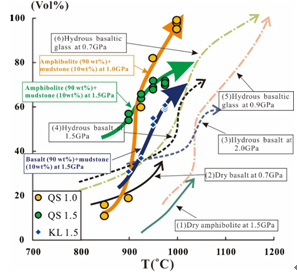2019年10月26日,太阳官网王明梁博士科研团队的臧春娟、王明梁在Journal of Asian Earth Sciences上在线发表了题为“Effects of sediment addition on magma generation from oceanic crust in a post-collisional extensional setting: constraints from partial melting experiments on mudstone–amphibolite/basalt at 1.0 and 1.5 GPa”(https://10.1016/j.jseaes.2019.104111)的研究论文。
论文摘要:
To assess the effects of sediment addition on magma generation from oceanic crust during post-collisional extension, we conducted partial melting experiments on amphibolite–mudstone (90 and 10 wt.%, respectively) and basalt–mudstone (90 and 10 wt.%, respectively) mixtures at 850 °C–1000 °C and 1.0 and 1.5 GPa. In the experimental products, partial melt coexists with Amp±Pl±Grt±Cpx at 1.0 GPa and Grt±Cpx±Amp at 1.5 GPa. Given the high water content of the sediment (>5 wt.%), the partial melts are hydrous even without the addition of water. Compared with previous partial melting experiments on (meta)basalts, our experiments yield similar phase assemblages (Amp±Pl±Grt±Cpx) but different P–T conditions for mineral stabilities. Sediment addition makes the residual minerals (Amp, Pl, and Cpx) more fusible and the crystallization of new minerals (Grt and Cpx) more difficult, thereby producing a high proportion of melt (>50 vol.%) at >900 °C. In the case of high-degree partial melting, the melt is enriched in Al2O3 and depleted in SiO2. Sediment addition enriches the partial melts in Rb, Th, U, and light rare earth elements, and results in high Y contents, low Sr/Y and very low LaN/YbN ratios. These effects are apparent in a natural example from east Junggar in northwest China, where granitoids have major and trace element features comparable with those of partial melts from the amphibolite–sediment mixture at 1.5GPa. This indicates that sediment addition has a significant effect on magma generation from oceanic crust in a post-collisional extensional setting.

Melting percentage of Mixtures [amphibolite/basalt (90wt%) + mudstone(10wt%)] increases sharply at over 925 oC and 1.0~1.5GPa (equal to 30~50km depth) compared with pure amphibolite/basalt.